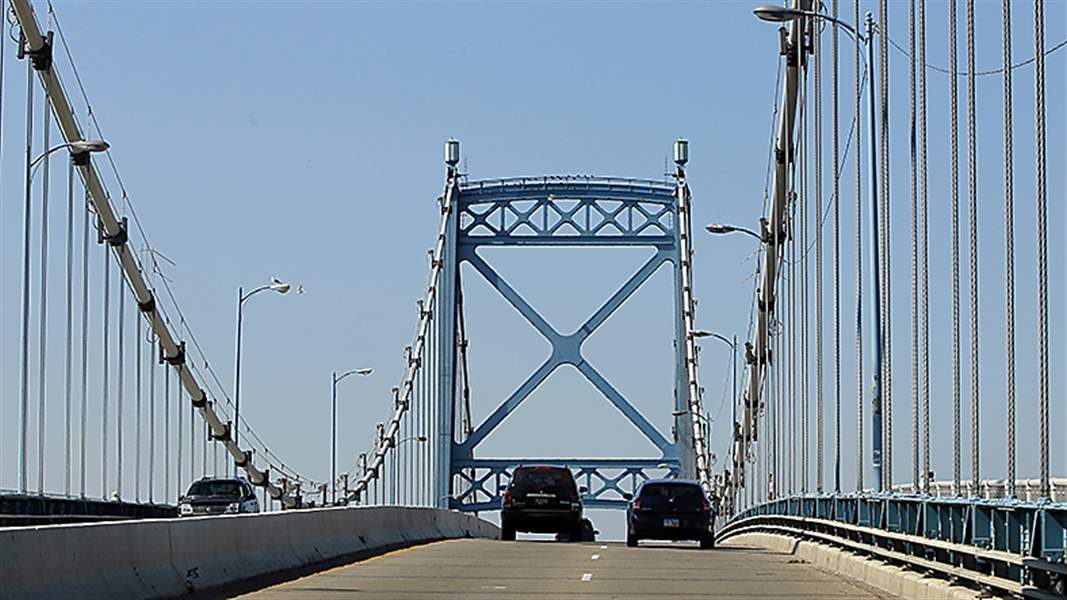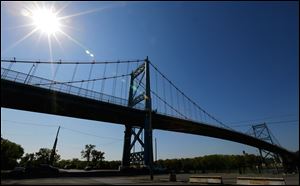
High Level Bridge work set to begin
Replacing trusses to eventually force closure of span by spring
10/2/2013
Preliminary lane closures on the Anthony Wayne Bridge will begin Monday and are to last about 10 weeks.
THE BLADE/ANDY MORRISON
Buy This Image

Preliminary lane closures on the Anthony Wayne Bridge will begin Monday and are to last about 10 weeks.
Just around the corner from Jamie Ondrus’ East Toledo hardware store, a landmark Toledo bridge used by many of his customers is about six months away from closing for about 19 months.
But Mr. Ondrus, proprietor of Ondrus Hardware — which has occupied its Oak Street location several decades longer than the 82 years the Anthony Wayne Bridge has spanned the Maumee River — isn’t outwardly worried about consequences of the bridge’s upcoming major renovation, for which preparatory work is set to start Monday.
“If you’ve ever walked that bridge … ,” he started to say. “I’d rather see the construction. It’s just due. I’d hate to see somebody get hurt up there.”
Pedestrian safety may be an issue, but for the Ohio Department of Transportation, the major work will include the replacement of truss-supported spans on either side of the bridge’s main suspension span, plus replacing the deck on the rest of the bridge and an extensive program of concrete and steel repairs.
Toledo-based E.S. Wagner’s $28.7 million contract is just over 9½ times more than the $3 million it cost to build the bridge between 1929 and 1931 — not adjusted for inflation, of course.
Since then, the structure also known as the High Level Bridge has undergone an extensive rehabilitation in 1960-1961 and, most recently, a lesser makeover in 1996 and 1997 that included resurfacing its concrete deck, joint repairs, cable replacement, and painting.

The deck replacement planned during the upcoming project is expected to last 50 years, state officials said.
Preliminary lane closings that start Monday are expected to last about 10 weeks, though that is “obviously weather dependent,” said David Geckle, ODOT’s project engineer. During that time, Wagner crews will set up safety platforms underneath the bridge’s main span for use during the deck replacement that will start as soon as weather warms up in the spring, he said.
“They need to work from above, with lane closures on the bridge to get equipment over the side,” Mr. Geckle said.
Work hours will be 7 a.m. to 5 p.m., and state officials said they will look into possibilities for waiting until after the morning rush hour for westbound lane closings, or wrapping up eastbound closings before the evening rush starts.
But once the major rehabilitation starts, the 24,000 or so vehicles that use the Anthony Wayne on a typical day will have to use a different bridge. The posted detour for State Rts. 2, 51, and 65 will use the I-75 DiSalle Bridge, but the nearby Martin Luther King, Jr., Bridge also is likely to be a popular alternative.
Mr. Ondrus said he already has been recommending alternate routes to his regular customers, so they become comfortable with them before they are forced to use them.

The Anthony Wayne Bridge.
“Thank goodness we have other bridges in this town that are done,” Mr. Ondrus said. “But once people find out, and get an alternate route, it will work. I give people credit to figure out another bridge to use.”
The closing is tentatively scheduled to start in March or April, and last through September or October, 2015.
“Once closure starts next spring, work will be going on all over the structure all the time,” Mr. Geckle said.
Once the main span’s deck is replaced, Wagner crews will move on to removing and replacing the approach spans with the trusses.
That has to be done all at once for the same reason those spans are being replaced, the project engineer said: the truss design has no structural redundancy to allow replacement one half at a time.
The lack of redundancy makes those 102-foot spans especially vulnerable to collapse should certain structural elements fail, as happened with a truss-design bridge on I-35W in Minneapolis that collapsed six years ago during a rehabilitation project with about 100 vehicles on it, killing 13 people and injuring 145.
Mr. Geckle said he expects the main span re-decking to take until late next fall to complete, after which the truss spans likely will be removed during the winter and replaced during the 2015 construction season.
The truss spans can’t be replaced concurrent with the main-span work because they’ll be needed for access, the project engineer said.
The shoreside work will require traffic disruptions on streets beneath the bridge — most notably, Miami Street between Stratton Street and Greenwood Avenue — but no schedule for closings on those streets has been determined.
The Wagner contract does not include repainting the bridge, which Theresa Pollick, the spokesman for ODOT’s Bowling Green district office, said will require lane closings in 2016.
Contact David Patch at:
dpatch@theblade.com
or 419-724-6094.